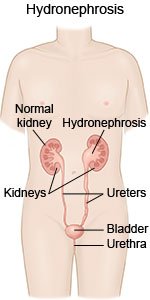Hydronephrosis in Children
Medically reviewed by Drugs.com. Last updated on Aug 4, 2025.
Hydronephrosis is swelling in one or both of your child's kidneys caused by urine buildup. Urine normally flows from the kidneys to the bladder through tubes called ureters. A blockage in the ureters can prevent urine from flowing properly. Blocked urine flow may be caused by a narrow ureter, a kidney stone, or reflux (urine travels back up to the kidney). It may also be caused by abnormal structure of your child's kidney. Examples include a ureter that drains outside the bladder or swelling at the bottom of the ureters.
 |
WHILE YOU ARE HERE:
Informed consent
is a legal document that explains the tests, treatments, or procedures that your child may need. Informed consent means you understand what will be done and can make decisions about what you want. You give your permission when you sign the consent form. You can have someone sign this form for you if you are not able to sign it. You have the right to understand your child's medical care in words you know. Before you sign the consent form, understand the risks and benefits of what will be done to your child. Make sure all of your questions are answered.
Medicines:
- Antibiotics help treat or prevent a bacterial infection.
- Pain medicine may be given. Do not wait until your child's pain is severe before you ask for more medicine.
Tests:
- Blood and urine tests will be used to check kidney function.
- X-rays or a CT scan may be taken of your child's kidneys, bladder, and ureters. Your child may be given contrast liquid to help the blockage show up better in the pictures. Tell the healthcare provider if your child has ever had an allergic reaction to contrast liquid.
- An ultrasound uses sound waves to show pictures of your child's kidneys and bladder on a monitor. An ultrasound may show if the kidneys are swollen or enlarged. It may also show blocked urine flow or abnormal structure.
- A voiding cystourethrogram , or VCUG, is an x-ray that will show urinary reflux. The pictures will show how well your child's bladder empties and if there is any blockage.
- A kidney scan will show how well your child's kidneys are working. This test may also show the cause of any blockage and if it is severe.
Treatment:
- Catheter or stent placement may be needed to help increase your child's urine flow. Your child may need a catheter (flexible tube) placed directly into his or her bladder to drain urine. Your child's healthcare provider may place a hard plastic tube called a stent inside your child's urinary tract to help urine pass from his or her kidney to his or her bladder.
- Surgery may be needed to remove the blockage so urine can drain normally. An abnormal structure may be fixed or a shunt may be placed to help widen a narrowed part of your child's urethra.
RISKS:
Urine buildup can cause swelling in one or both of your child's kidneys. Swelling can lead to long-term kidney damage. Your child may have trouble controlling when he or she urinates if he or she has a partial blockage. Severe hydronephrosis may cause a blood infection called sepsis. Sepsis is toxin (poison) buildup in your child's blood. It happens when your child's kidneys cannot flush toxins out of his or her body. Without treatment, your child's kidneys may stop working. These conditions may become life-threatening.
CARE AGREEMENT:
You have the right to help plan your baby's care. Learn about your baby's health condition and how it may be treated. Discuss treatment options with your baby's healthcare providers to decide what care you want for your baby.© Copyright Merative 2025 Information is for End User's use only and may not be sold, redistributed or otherwise used for commercial purposes.
The above information is an educational aid only. It is not intended as medical advice for individual conditions or treatments. Talk to your doctor, nurse or pharmacist before following any medical regimen to see if it is safe and effective for you.
Learn more about Hydronephrosis
Treatment options
Care guides
Further information
Always consult your healthcare provider to ensure the information displayed on this page applies to your personal circumstances.
